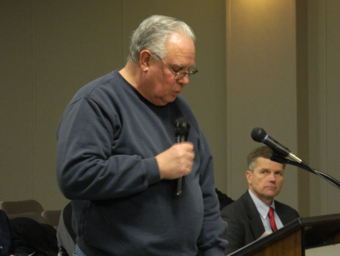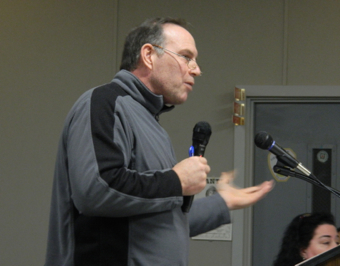 Proposed revisions to Shelton’s land use regulations to restrict the raising of chickens in residential areas received mixed feedback Wednesday (Jan. 28) at a hearing of the Planning and Zoning Commission.
Proposed revisions to Shelton’s land use regulations to restrict the raising of chickens in residential areas received mixed feedback Wednesday (Jan. 28) at a hearing of the Planning and Zoning Commission.
The proposal, which would allow residents to raise chickens only if they own about an acre or more of land, reflects the city’s transition from predominantly rural farming community to residential suburb.
A handful of residents offered thoughts on the new rules Wednesday. A Walnut Tree Hill road couple said the proposed restrictions were too lax. But two other residents worried that the regulations would be too restrictive.
And the chairman of the city’s Zoning Board of Appeals, which asked officials to modify the regulations in the first place, pointed out some parts of the regulations as proposed could become problematic if adopted.
The commission took no action on the proposal Wednesday, instead continuing the hearing to Feb. 25 with a view to getting more public input.
Background
Before the days of Route 8 and corporate office towers and every business you could ever think of opening on Bridgeport Avenue, Shelton was in large part an agricultural community, with farms dotting a landscape now dominated by housing subdivisions.
Some farms remain in town, but others, like Dikovsky’s Poultry and Eggs, a 13-acre farm off Old Town Road the city purchased to preserve as open space, are now history.
In 1952, the city first adopted a zoning ordinance allowing residents to raise up to 20 chickens on lots smaller than two acres.
At the time, the city’s population was about 13,000.
Fast forward to 2004. With about three times as many residents, according to zoning officials, the free roaming of poultry and crowing of roosters in residential areas had become a public nuisance, so the city amended their regs to set a minimum lot size of five acres to keep or raise live poultry.
People who raised chickens on properties fewer than five acres before the 2004 change were exempt and were allowed to keep doing so.
But in 2014, the commission received a complaint from a neighbor of a couple on Walnut Tree Hill road who were raising chickens on a two-acre plot of land. The property’s owners took the case to the city’s Zoning Board of Appeals, which asked the planning and zoning commission to revisit their rules.
Tom Dingle, a city zoning official, said he receives about five complaints a year regarding chickens on residential properties.
Most of the complaints are based on noise from roosters and free-roaming birds, though in some cases, the chickens also attracted vermin.
“In the old days you could have a sixteenth of an acre and 20 chickens,” Dingle said. “Basically, managing your manure is the big thing. Rats like to eat chicken feed and chicken manure, so that attracts them.”
Proposal
So zoning officials came up with some new rules which would ban roosters on any properties fewer than 200,000 square feet and also mandate:
- No more than five chickens on residential properties between 40,000 square feet and 80,000 square feet;
- No more than 10 chickens on residential properties between 80,000 and 199,999 square feet;
- Chickens to be enclosed in coops at all times, and at least 50 feet from any property lines, appropriately screen from other properties by fencing or plantings;
- No sales of eggs or chickens from the properties;
- Inspection, if necessary, of the chickens’ living conditions by the Lower Naugatuck Valley Health District and/or the state’s Department of Health.
Article continues after document.
Shelton Chicken Zoning Amendments
‘Nightmare’ Or Reasonable Use?
Reaction from residents was mixed.
Robert Zaleski, a Walnut Tree Hill Road resident, read a letter he and his wife wrote opposing the new regulations.
Zaleski worried a proliferation of chicken-raising in residential areas would create sanitation problems.
“Spilled chicken feed and chicken droppings will attract rats,” Zaleski said. “On a chicken farm with proper acreage, feral cats are usually present to mitigate the problem. With chickens being raised in the close confines of lesser land area, the rat infestation will become prevalent with no natural controls.”
 “Fresh eggs are available in many areas from local egg farmers, whose property is maintained as a farm,” Zaleski went on. “Don’t we like to support our local farmers?”
“Fresh eggs are available in many areas from local egg farmers, whose property is maintained as a farm,” Zaleski went on. “Don’t we like to support our local farmers?”
He also worried the regulations would be difficult to enforce.
“Who is going to monitor this?” he wondered. “Will we have to hire a fill-time or part-time chicken checker?”
The Zaleskis said they’ve seen the problems of raising livestock on residential property first-hand, after a neighbor on Elizabeth Street started raising livestock on their property.
Robert Zaleski said the property has been turned into a “nightmare,” and said he’s seen his neighbors dumping waste into a brook that runs though his property. He said they continue to do so, even after he and his wife complained to the city.
Matt Jenness, a resident of Earl Street who said he raises seven chickens on a one-acre property, said the proposed regulations were “a little restrictive.”
More and more people are becoming more conscious of where the food they eat comes from, he said, which is a good thing.
“The bottom line is now it’s becoming more popular because everybody wants to be self-sustaining, eat organic food, etc.,” he said. “They know that it’s organic because they raise it themselves.”
 Jenness, who said he allowed his own chickens to roam his property until a neighbor complained, asked that the PZC adopt regulations allowing for free-roaming chickens because their eggs are healthier and they eat ticks.
Jenness, who said he allowed his own chickens to roam his property until a neighbor complained, asked that the PZC adopt regulations allowing for free-roaming chickens because their eggs are healthier and they eat ticks.
“If someone complains, you need to take care of it,” he said. “But if no one complains about free range chickens, I say let them go.”
Jenness also said that manure could create problems if it accumulates, but pointed out he recycles his own chickens’ manure in his garden. He also said that “six hens produce about the same amount of manure as one medium dog.”
“So I question why we’re regulating chickens and not other animals,” he said.
And at least on his own property, the manure is the product of food waste he feeds his chickens that would otherwise pile up in landfills.
“Again, there has to be limits,” Jenness conceded. “We’re in a city. But within reason.”
To that end, Jenness asked the commission to allow people to raise up to two chickens on a quarter-acre lot; four on a half-acre lot; six on a three-quarter-acre lot; and up to eight on an acre of land.
He said limiting the keeping of chickens only to residents who own at least an acre of land would be regressive.
Janet Laskos, of Perch Road, agreed, saying that while some rules are needed regulating the amount of chickens depending on how big a residential property is, the rules as proposed would be too restrictive.
More people raising chickens would help the local economy, she said.
“When you allow the chickens you’re also going to have people that need to buy feed for the chickens,” Laskos said. “So that will help local businesses because we’ll support them for the feed and the coups. I think it brings a sense of community, and I’m for it.”
ZBA Chairman Weighs In
Ed Conklin, the chairman of the city’s Zoning Board of Appeals, thanked the PZC for taking up the issue but pointed out a handful of potential issues with the proposed regulations as written.
For one, he said the 50-foot setback might be problematic in terms of not giving residents enough leeway.
“As they stand, a lot of that’s going to set (the only location they could put a coop) right in the middle of the building lot itself,” he said.
He also pointed out the proposal is confusing because it says residents can raise up to five chickens on lots between 40,000 and 80,000 square feet, but 10 on lots of 80,000 to 199,999 square feet. The regulations should delineate more clearly how many chickens a person could raise on a lot of exactly 80,000 square feet.